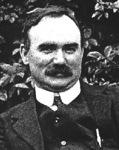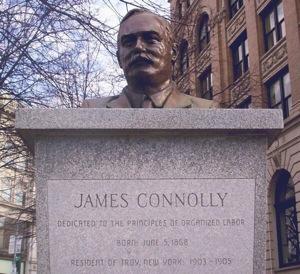By Jim Hargreaves
One hundred years ago the Irish Citizen Army was founded in response to the brutality of strikebreaking in Ireland, which was mainly done by the Dublin Metropolitan Police. It’s aim was to defend strikers and workers from the barbaric attacks of the police.
One of the co-founders of the ICA was a man called James Connolly.

By 1915, Britain had as much control of Ireland as it did over England. Home rule was suspended until the end of the war, and Connolly’s paper ‘The Workers’ Republic was shut down by the authorities in Dublin castle.
James Connolly was appointed acting General Secretary of the Irish Transport and General Workers Union. By now, Connolly had become very militant. He paraded units of the Irish Citizens Army in Dublin, but such displays made those who had left the Irish Volunteers and gone to the Irish Republican Brotherhood (IRB) very anxious, as they were planning to start an uprising. They felt that such displays would attract the attention of the authorities, which would crush the uprising before it even began. In an effort to bring Connolly on board and to tame his more wild displays of militancy, the IRB took him into their confidence. Connolly was told about the planned rebellion for Easter 1916. After this, Connolly took an active part in the preparations and he was appointed Military Commander of the Republican Forces in Dublin, which encompassed the Irish Citizens Army.
When the uprising started on Monday 24th April, James Connolly was one of the seven signatories to the Proclamation. Connolly was in command of the General Post Office during the rebellion – the rebels headquarters. He was severely wounded during the fighting and was arrested once the rebels had surrendered. After the surrender, Connolly stated this:
“Don’t worry. Those of us that signed the proclamation will be shot. But the rest of you will be set free.”
He was court-martialled in a military hospital in Dublin. Charged with treason, there was no doubt as to what the verdict and punishment would be.
At his court martial, Connolly made the following statement:
“We want to break the connection between this country and the British Empire, and to establish an Irish Republic. “
“We succeeded in proving that Irishmen are ready to die endeavouring to win for Ireland those national rights which the British government has been asking them to die, to win for Belgium. As long as that remains the case, the cause of Irish freedom is safe. I personally thank God that I have lived to see the day when thousands of Irish men and boys, and hundreds of Irish women and girls, were ready to affirm that truth, and to attest it with their lives if need be”
James Connolly was sentenced to death. Some of the employers with whom he had battled in the ‘Great Lock-Out’ of 1913, called on the British government to execute Connolly.
On May 12th,1916, Connolly was shot by firing squad. He had been taken by military ambulance to Kilmainham Prison, carried on a stretcher to a courtyard in the prison, tied to a chair and shot. With the other executed rebels, his body was put into a mass grave with no coffin. All the executions of the rebels angered many Irish people who had shown little support for the rebels during the rebellion. However, it was the circumstances of Connolly’s execution that created the most anger.
Connolly was among the few European members of the Second International who opposed, outright, World War I. This put him at odds with most of the socialist leaders of Europe, most of whom betrayed the working class by condoning an imperialist land-grab which pitted proletarian against proletarian.


